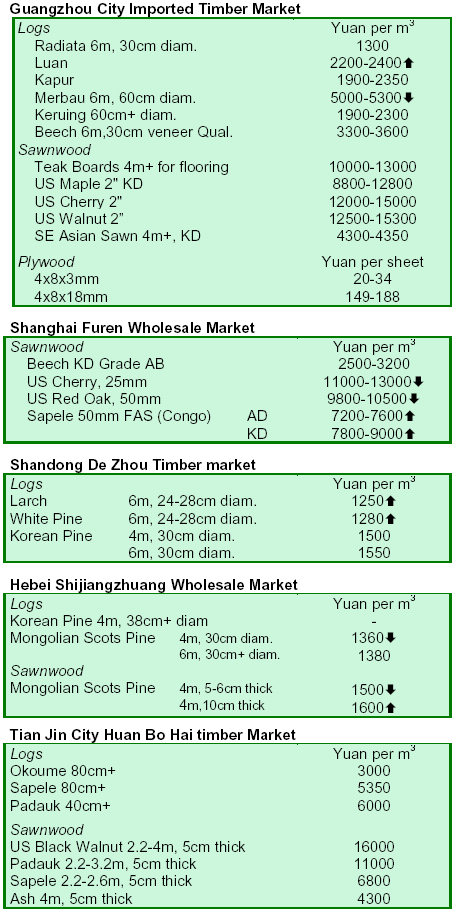US
Dollar Exchange Rates of 15th Oct.
2007
China Yuan
7.528
Report from China
China to promote its overseas forest products industry
To further promote the development of China¡¯s economy and trade, the Chinese government has announced a
development strategy to allow eligible enterprises to actively seek foreign
investment. In light of this new strategy, a series of government documents has been
released such as a guidebook on China¡¯s industrial investment overseas and measures on special capital for
foreign economic and technological cooperation. The documents were issued jointly by the
Ministry of Commerce, the Ministry of Finance, the Ministry of Foreign Affairs, the People¡¯s
Bank of China and theGeneral Administration of China¡¯s Customs Agency.
The guidebook on China¡¯s overseas industrial investment suggested Chinese companies look to Thailand, Laos,
Myanmar, Vietnam, Malaysia, Canada, Uganda, Ukraine and Guyana for opportunities in the paper making and
products sector. Among the countries singled out as a source of investment for wood processing were Myanmar,
New Zealand, Papua New Guinea, Vanuatu, Sierra Leone, the Congo, Gabon, the Democratic Republic of Congo and
Guyana. The guidebook also suggested that Mongolia, Mali, South Africa, Sweden, Nepal, Yemen, Guinea,
Angola, Spain, Kuwait, Cameroon and Ghana were countries thought to be good prospects for
investors in building materials.
China¡¯s bamboo chopsticks exports expected to boom
China¡¯s export of bamboo chopsticks is expected to be prosperous. Three primary reasons
contribute to this expectation. First, China has rich bamboo resources and
ranks first in stocking volume and output in the world. Bamboo has shorter growth cycles and is a recyclable
resource. Developing bamboo production will help meet national goals to save resources and
create a more environmentally friendly society. Second, China has poor timber resources and
has issued a series of policies to restrict the development and export of disposable
products. In light of this, China has issued a requirement to reduce the domestic usage of wooden
chopsticks in a new management standard for catering enterprises, effective 1 December 2007. Third, the production and
export of bamboo chopsticks enterprises have the potential to make improved profits than those for wooden
chopsticks.
Fast growing multi-layered poplar plywood developing rapidly
Fast growing multi-layered poplar has helped China¡¯s plywood production grow rapidly since the 1990s. The
major production regions for poplar have been south of the Yellow River and north of the Yangtze River. In the east
of China, Pizhou and Suquian City in Jiangsu Province and Linyi and Heze City in Shandong Province were the
major production regions. In the eastern regions, about 10,000 different kinds and sizes of plywood enterprises
have been established with 100 employees. The annual output of multi-layered plywood has exceeded 20 million
m3, making up 70% of the national total plywood output. Five million m3 of poplar multi-layered plywood was
exported in 2006, accounting for 60% of the national total.
Farmers¡¯ initiatives to plant poplar are greatly motivated by the increasing price of poplar in
recent years. The price for larger diameter poplar was only RMB300 per m3 in
2004, but rose to RMB1,000 per m3 in 2007, making it nearly a three fold increase in price. At present, many
farmers in the above regions now widely plant poplar in the front or back of their houses, at the
side of a road or a farmland shelter, and the poplar regenerates every six to
eight years.
Given its price and fast growing rate, poplar has been the best way to eliminate poverty for many local farmers. A
whole fast growing poplar industry supply chain has beenformed in local areas,
driving not only the local economy, but also mitigating the pressure from domestic timber
demand. As a result, local governments suggest that the country support the fast growing poplar industry when it
develops its macro policies.
Exhibition highlights importance of China¡¯s bamboo and rattan industry
On 22 September 2007, the ¡®China International Bamboo and Rattan Expo and Online Exhibition 2007¡¯ was held to
celebrate, inter alia, the ten year anniversary of the International Network on
Bamboo and Rattan (INBAR). Madame Jiang Zehui attended the exposition in her
capacity of co-chair of the board for INBR and said that bamboo and rattan are two kinds the most valuable nonwood
forest products in the international trade and play an important role in eliminating forest logging, strengthening
environment protection, mitigating poverty and encouraging sustainable development of the rural
economy.
At present, more than one billion people in the world live on bamboo and rattan. China is rich
with bamboo and rattan resources. There are 37 families or 500 species of bamboo plants
making up 4.84 million hectares of bamboo in China. China leads in global bamboo cultivation,
processing and utilization. China¡¯s bamboo industry covers construction, sawnwood, house
furnishing, biochemistry, medical care, spinning, food, paper making, tourism, environmental construction, and urban greening.
The current value of China¡¯s bamboo products has reached USD1.1 billion, with the export value of 30 bamboo
production regions making up 50% of the national total.
Rattan resources are rich in China, with 25 species of rattan naturally occurring in China.
Mechanization and semi-mechanization have been realized in the rattan industry and 150,000
employees work in the rattan industry. The total value of China¡¯s foreign trade for rattan
products amounts to USD200 million and continues to grow at a 10% annual rate.

¡¡
|